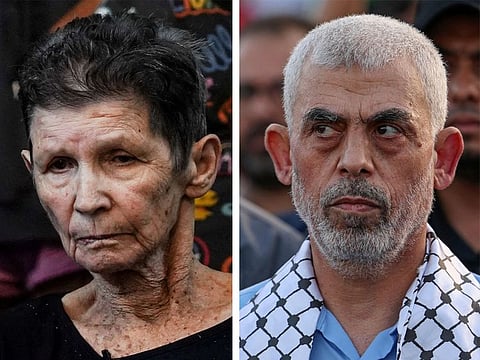Israeli ex-hostage and peace activist says she confronted Hamas boss Yahya Sinwar in Gaza tunnel
She asked him how he is not ashamed to do such thing to people who have supported peace

Jerusalem: An 85-year-old Israeli woman abducted by Hamas on October 7 and set free two weeks later said she met its Gaza leader Yahya Sinwar while in captivity and asked him how he was not ashamed for having acted violently against peace activists like herself.
Yocheved Lifshitz, 85, was taken from her Kibbutz Nir Oz home in Israel to Gaza. She told the Israeli newspaper Davar she confronted Sinwar when he visited the hostages in an underground tunnel where Hamas was holding them captive.
“Sinwar was with us three to four days after we arrived,” Lifshitz told the Hebrew-language Davar newspaper. “I asked him how he is not ashamed to do such a thing to people who all these years have supported peace.” “He didn’t answer. He was silent,” she said.
Lifshitz is a peace activist who, together with her husband, helped sick Palestinians in Gaza get to hospital for years, her grandson told Reuters. Her 83-year-old husband, Oded, was also kidnapped from their home and remains in captivity.
Speaking with reporters following her release from Hamas captivity last month, Lifshitz said that she “went through hell” during her two weeks as a hostage in the Gaza Strip.
Lifshitz was one of four women freed by Hamas early in the war. She said she had been beaten when she was abducted but was then treated well during her two-week captivity.
On her release, she turned to shake the hand of a masked captor. Asked why, she replied: “They treated us gently and met all our needs.”
Who is Sinwar?
After a career in the shadows, spent in Israeli prisons and the internal security apparatus of Hamas, Yahya Sinwar rose to lead the Islamist movement in the Gaza Strip.
Now, Israeli officers say, he is a “dead man walking”.
Sinwar stands accused of masterminding the group’s October 7 attacks, the worst in Israel’s history, which officials say left around 1,200 people dead and about 240 dragged back to Gaza as hostages.
It was probably a year or two in the planning, “took everyone by surprise” and “changed the balance of power on the ground”, said Leila Seurat of the Arab Centre for Research and Political Studies (CAREP) in Paris.
The ascetic 61-year-old has not been seen since October 7. Known for his secrecy, Sinwar is a security operator “par excellence”, according to Abu Abdallah, a Hamas member who spent years alongside him in Israeli jails.
“He makes decisions in the utmost calm, but is intractable when it comes to defending the interests of Hamas,” Abu Abdallah told AFP in 2017 after his former co-detainee was elected Hamas’s leader in Gaza.
Punishing collaborators
After October 7, Israeli military spokesman Lieutenant Colonel Richard Hecht called Sinwar the “face of evil” and declared him a “dead man walking”.
Born in the Khan Younis refugee camp in southern Gaza, Sinwar joined Hamas when Sheikh Ahmad Yassin founded the group around the time the first Palestinian intifada began in 1987.
Sinwar set up the group’s internal security apparatus the following year, and went on to head an intelligence unit dedicated to flushing out and mercilessly punishing - sometimes killing - Palestinians accused of providing information to Israel.
According to a transcript of an interrogation with security officials published in Israeli media, Sinwar professed to have strangled an alleged collaborator with a keffiyeh scarf in a Khan Yunis cemetery.
A graduate of the Islamic University in Gaza, he learned perfect Hebrew during his 23 years in Israeli jails, and is said to have a deep understanding of Israeli culture and society.
He was serving four life terms for the killing of two Israeli soldiers when he became the most senior of 1,027 Palestinians released in exchange for Israeli soldier Gilad Shalit in 2011.
Sinwar later became a senior commander in the Ezzedine Al Qassam Brigades, the military wing of Hamas, before taking overall leadership of the movement in Gaza.
While his predecessor had encouraged efforts by Hamas to present a moderate face to the world, Sinwar has preferred to force the Palestinian issue to the fore by more violent means.
Gaza’s Hamas government says Israel’s withering aerial and ground assault launched in response to the October 7 attacks has killed nearly 15,000 people in the Palestinian territory, most of them civilians.
‘Radical and pragmatic’
Sinwar dreams of a single Palestinian state bringing together the Gaza Strip, the occupied West Bank - controlled by Mahmoud Abbas’s Fatah party - and annexed east Jerusalem.
According to US think tank the Council on Foreign Relations, he has vowed to punish anyone obstructing reconciliation with Fatah, the rival political movement with which Hamas engaged in factional fighting after elections in 2006.
That coming together remains elusive, but the prisoner releases resulting from the current truce agreement with Israel have seen Hamas’s popularity soar in the West Bank.
Sinwar has pursued a path of being “radical in military planning and pragmatic in politics”, according to Seurat.
“He doesn’t advocate force for force’s sake, but to bring about negotiations” with Israel, she said.
The Hamas chief was added to the US list of the most wanted “international terrorists” in 2015, as was Mohammed Deif, the current commander of the Ezzedine Al Qassam Brigades and another alleged October 7 mastermind.
Security sources outside Gaza say that both Sinwar and Deif have taken refuge in the network of tunnels built under the territory to withstand Israeli bombs.
Vowing earlier this month to “find and eliminate” Sinwar, Israeli Defence Minister Yoav Gallant urged Gazans to turn Sinwar in, adding “if you reach him before us, it will shorten the war”.
Sign up for the Daily Briefing
Get the latest news and updates straight to your inbox



